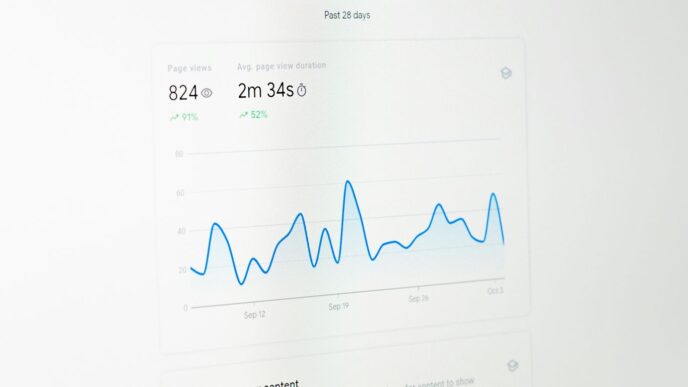So, 2025 is just around the corner, and if you’re trying to get your content noticed, things are definitely changing. It feels like every week there’s a new tool or a new way people are looking at stuff online. We’re talking about how to make content that actually sticks, not just something that gets lost in the noise. It’s all about being smart with what you make and how you put it out there. We’ll look at some ways to make your content stand out and actually connect with people.
Key Takeaways
- Use AI to help create and fine-tune your content, making it more personal and efficient.
- Video is huge, especially short clips and live streams, and don’t forget to think about how people ask questions using their voice.
- Telling real stories that feel genuine is still super important for building connections.
- Even with all the tech, remember to keep a human touch in your content to build trust.
- Try different kinds of content, like pictures and audio, to reach more people.
Leveraging Artificial Intelligence for Innovative Content

It feels like AI is everywhere these days, right? And for good reason. It’s not just a buzzword anymore; it’s becoming a real workhorse for content creators looking to do things a bit differently in 2025. Think of AI as your super-smart assistant, the one who can sift through mountains of data and spot patterns you’d probably miss. This ability to process information quickly is what makes AI so powerful for content innovation.
AI-Driven Content Creation and Optimization
So, how does this actually work? AI tools can help brainstorm ideas, which is always a good start when you’re staring at a blank page. They can look at what’s already out there, what’s popular, and suggest topics that might actually connect with people. Beyond just ideas, AI can help refine your writing. It can check for clarity, suggest better phrasing, and even help make sure your content is set up to be found by search engines. It’s like having a built-in editor and strategist rolled into one. For instance, AI can analyze successful content in your area and point out common themes or structures that tend to work well. This isn’t about replacing human creativity, but about giving it a boost.
Personalizing Experiences with AI Insights
Remember when content felt a bit generic? AI is changing that. By looking at how people interact with your content – what they click on, what they spend time reading, what they share – AI can help figure out what different groups of people are interested in. This means you can start showing them content that’s more relevant to them. It’s not just about putting their name in an email; it’s about understanding their preferences and historical data to deliver truly targeted messages. This kind of personalization makes people feel seen and understood, which is a big deal for building relationships. It’s about making sure the right message gets to the right person at the right time, making their experience with your brand much better.
Enhancing Efficiency Through Automation
Let’s be honest, some content tasks are just plain repetitive. Scheduling social media posts, sending out follow-up emails, even basic content formatting – AI can take a lot of that off your plate. Automation tools, powered by AI, can handle these routine jobs without you needing to lift a finger. This frees up your team to focus on the more creative, strategic parts of content marketing, like developing new campaign ideas or really digging into audience research. Imagine spending less time on manual tasks and more time on creating truly impactful content. It’s about working smarter, not just harder, and making sure your resources are used where they’ll have the biggest effect. This approach helps businesses scale their content operations and meet the changing demands of the market, which is key for staying competitive in the digital age. Innovation thrives at the intersection of AI and digital strategy, and AI serves as a potent tool for data comprehension and idea generation, but true innovation often requires a synergistic relationship between AI capabilities and strategic digital implementation [defc].
| Task Area | AI Assistance | Benefit |
|---|---|---|
| Content Ideation | Trend analysis, topic suggestion | Faster idea generation |
| Content Optimization | SEO keyword suggestions, readability checks | Improved search visibility, clearer messaging |
| Personalization | User behavior analysis, content tailoring | Higher engagement, better user experience |
| Workflow Automation | Post scheduling, email campaigns | Time savings, increased team focus on strategy |
The Ascendancy of Video and Voice Search
Okay, so let’s talk about video and voice search. It feels like video has been king for a while now, right? But it’s not slowing down. By 2025, if you’re not thinking video, you’re probably missing out.
Dominance of Short-Form and Interactive Video
Think TikTok, Reels, Shorts. These quick, punchy videos are everywhere. They grab attention fast, which is exactly what we need in a world that’s always scrolling. Brands are using them to show off products, tell quick stories, or just be a bit more fun. It’s not just about watching anymore, either. Interactive videos are popping up, letting viewers click on things, answer questions, or even choose their own adventure. It makes people feel more involved, you know? Like they’re part of the content, not just looking at it.
Here’s a quick look at what’s working:
- Short-form videos: Great for quick tips, behind-the-scenes peeks, or product demos.
- Live streaming: Perfect for Q&As, event coverage, or real-time product launches.
- Interactive videos: Boosts engagement by letting viewers make choices or click on elements.
Optimizing Content for Conversational Voice Search
And then there’s voice search. With smart speakers and phone assistants becoming so common, people are talking to their devices way more. They’re not typing out keywords like they used to; they’re asking full questions. So, our content needs to sound natural, like we’re having a conversation.
Think about how you’d ask your phone for something. You’d probably say, "Hey, what’s the best way to make sourdough bread?" not "sourdough bread recipe best." We need to start writing content that answers those kinds of natural questions. Using longer phrases and question-based keywords is going to be key. It’s about being there when people ask, not just when they type.
Live Streaming for Real-Time Engagement
Live streaming is a big part of this video trend. It’s raw, it’s immediate, and it lets you connect with your audience right then and there. You can answer questions as they come in, show off something new as it happens, or just have a casual chat. This kind of real-time interaction builds a stronger connection than pre-recorded stuff ever could. It feels more genuine, and people appreciate that. Plus, it gives you instant feedback on what your audience is thinking and feeling. It’s a direct line to your community.
Cultivating Authentic Connections Through Storytelling
Look, we all know the internet is a noisy place. With all the new tech popping up, it’s easy to get lost in the shuffle. But here’s the thing: people still want to connect with real stuff, with brands that feel like, well, people. That’s where good old-fashioned storytelling comes in. It’s not just about selling a product; it’s about sharing who you are and what you stand for.
The Enduring Power of Authentic Brand Narratives
Think about your favorite brands. Chances are, they don’t just push ads at you. They tell stories. Maybe it’s about how they started, the challenges they overcame, or the impact they’re making. These genuine narratives are what make a brand memorable and relatable. When you share your brand’s journey, its values, and even its stumbles, you’re showing the human side. This builds trust, and trust is gold. It’s like talking to a friend rather than a salesperson. In 2025, as AI gets even smarter, this human element will be more important than ever. People will seek out brands that feel real.
Positioning the Audience as the Hero of the Story
It’s easy to get caught up talking about your brand all the time. But what if you flipped the script? Instead of making your brand the star, make your customer the hero. What problems are they facing? How does your brand help them win? When you frame your stories around your audience’s needs and aspirations, they see themselves in your narrative. They become the protagonist in their own journey, with your brand as the helpful sidekick. This approach makes your content way more engaging because it’s actually about them.
Building Community with Genuine Brand Voices
Creating content is one thing, but building a community around it is another. A genuine brand voice is key here. It’s about being consistent, honest, and approachable across all your platforms. Think about it: if your brand sounds different on Instagram than it does in an email, it feels off, right? A consistent voice helps people know what to expect and feel more connected. It’s about showing up regularly with content that’s helpful, interesting, or even just fun, and doing it in a way that feels like you. This builds loyalty and turns casual followers into a real community that sticks around.
Human-Centered Strategies in an Automated World

Okay, so AI and all that automation stuff is pretty cool, right? It can whip up content faster than you can say ‘algorithm’. But here’s the thing: people still want to connect with other people. We’re not just data points; we’re looking for genuine interactions.
Balancing Technology with the Human Touch
Think about it. You get an email that’s clearly written by a robot, all stiff and formal. Then you get one that sounds like a real person, maybe even cracks a joke. Which one are you more likely to read? It’s the same with content. AI can help us be more efficient, sure. It can analyze what people like and suggest topics. But it can’t replicate that spark of human creativity or empathy. We need to use these tools to make our jobs easier, not to replace the actual human connection.
Here’s a quick look at how we can keep that human element front and center:
- Use AI for the grunt work: Let it help with research, drafting, or even scheduling. This frees you up for the creative stuff.
- Inject personality: Write like you talk. Use your brand’s unique voice, even if it’s a bit quirky.
- Show, don’t just tell: Instead of just saying your brand is caring, show it through stories or customer spotlights.
Fostering Loyalty Through Relatable Content
People stick around when they feel understood. When your content reflects their experiences, their struggles, and their wins, they feel a connection. It’s like finding someone who gets you. This isn’t about being perfect; it’s about being real.
Consider this breakdown of what makes content relatable:
- Shared Experiences: Content that touches on common challenges or joys.
- Authentic Voices: Using real people (employees, customers) in your content.
- Vulnerability: Admitting when things don’t go perfectly can actually build trust.
The Value of Transparency and Empathy
In a world that can sometimes feel a bit cold and impersonal, being open and understanding goes a long way. If you mess up, own it. If you’re excited about something, let that show. Empathy means trying to see things from your audience’s perspective. What are they worried about? What are they hoping for? When your content addresses that, you’re not just selling something; you’re building a relationship. It’s about making people feel seen and heard, and that’s something no amount of automation can truly replace.
Mastering Diverse Content Formats for Reach
It’s easy to get stuck in a rut, right? You find a content format that works, and you just keep doing it. But the internet is a big place, and people like different things. To really get your message out there in 2025, you’ve got to mix it up. Think about it – not everyone wants to read a long article, and not everyone has time to watch a full video. So, how do you reach more people?
The Impact of Infographics and Visual Content
Let’s talk visuals. Infographics are like the superheroes of explaining complicated stuff. You can take a bunch of data or a complex process and turn it into something that’s actually easy to look at and understand. People scroll through social media fast, and a good infographic stops them. They’re also super shareable, which means more eyes on your brand without you having to do much extra work. It’s a win-win.
Here’s a quick look at why visuals matter:
- Quick Consumption: People can get the gist in seconds.
- High Shareability: Visuals get passed around more easily online.
- Better Retention: We tend to remember things we see better than things we just read.
Engaging Audiences with Podcast Narratives
Podcasts are another big deal. Think about your commute, your workout, or even just doing chores around the house. People are listening. A podcast lets you get a bit more personal with your audience. You can tell stories, discuss trends, or just chat about what’s happening in your industry. It creates a connection that’s different from just reading something. It feels more like a conversation, and that builds loyalty.
Experimenting with Emerging Content Mediums
And then there are the new things popping up. What’s next? Who knows for sure, but being willing to try new platforms or formats is key. Maybe it’s interactive quizzes, augmented reality experiences, or something we haven’t even thought of yet. The brands that do well in the future will be the ones that aren’t afraid to experiment. Don’t just stick to what’s comfortable. Try something new, see how your audience reacts, and adjust. It’s how you stay relevant and keep people interested.
Data-Driven Personalization for Deeper Engagement
Okay, so we’ve talked a lot about AI and video, but how do we actually make sure all that cool content hits the right people? That’s where data-driven personalization comes in. It’s not just about throwing stuff out there and hoping for the best. It’s about using what we know about our audience to make sure what they see is actually relevant to them. This means moving beyond generic messages and crafting experiences that feel like they were made just for them.
Think about it. If someone keeps looking at hiking boots on your site, sending them emails about winter coats probably isn’t going to get much of a reaction. But if you send them a guide to the best local trails or a discount on those boots? Much better chance they’ll pay attention. It’s about being smart with the information we have.
Utilizing Analytics for Targeted Content
So, how do we get this smart? Analytics, plain and simple. Tools like Google Analytics or the insights you get from social media platforms are goldmines. They tell us who’s visiting, what they’re clicking on, how long they’re sticking around, and even when they’re most active. We can see which blog posts get the most reads, which videos get the most plays, and where people tend to drop off. This isn’t just numbers; it’s a map of our audience’s interests.
Here’s a quick look at what we can track:
- Page Views: Which pages are getting the most attention?
- Click-Through Rates (CTR): Are our calls to action working?
- Bounce Rate: Are people leaving immediately, or are they exploring?
- Time on Page: How engaged are they with specific content?
By looking at this data, we can start to see patterns. Maybe your audience really loves "how-to" guides, or perhaps they respond best to customer testimonials. Knowing this lets us create more of what works and less of what doesn’t. It’s about making our content efforts count.
Crafting Hyper-Personalized User Journeys
Once we have that data, we can start building out what I like to call "hyper-personalized user journeys." This is where we take the insights from analytics and apply them to create a more tailored experience for each person. It’s like having a conversation with each visitor, but on a much larger scale.
For example, if someone has visited your site multiple times and looked at a specific product category, we can automatically show them related products or articles when they return. Or, if they’ve signed up for a newsletter about a certain topic, we can send them more in-depth content on that subject. This level of tailored engagement is what data-driven personalization is all about. It makes people feel seen and understood, which is a big deal in today’s crowded online space.
Interactive Content for Audience Participation
Finally, let’s talk about making this personalization a two-way street. Interactive content is fantastic for this. Quizzes, polls, calculators, and surveys aren’t just fun; they’re also powerful tools for gathering more specific data about your audience while simultaneously giving them a personalized experience.
Imagine a quiz that helps users figure out which of your products is best for them. Not only does the user get a recommendation tailored to their needs, but you also get valuable data about their preferences. This kind of interaction builds a stronger connection and provides even more information to refine future personalization efforts. It’s a win-win, really.
Wrapping It Up: Your Content Game Plan for 2025
So, as we wrap this up, it’s pretty clear that content in 2025 is going to be a mix of smart tech and real human connection. We’ve talked about how AI can help us work faster and smarter, making things more personal for people. But don’t forget the human side – telling real stories and being genuine is still super important for building trust. It’s not just about using the latest tools; it’s about using them to connect better. Think about mixing up how you share stuff, maybe trying out video or podcasts, and always keeping your audience in mind. By staying flexible and focusing on what truly matters to people, your content will stand out and do what it’s supposed to do.
Frequently Asked Questions
What is content marketing and why is it important for 2025?
Content marketing is like making cool stuff (like articles, videos, or pictures) to get people interested in your brand. It’s important because it helps people trust you and makes them want to buy from you. In 2025, it’s even more important because there’s so much stuff online, and good content helps you stand out.
How is Artificial Intelligence (AI) changing content creation?
AI is like a super-smart helper for creating content. It can help come up with ideas, write parts of articles, and even make your content better for people to find. This means you can make more content, faster, and make it more interesting for each person.
Why are video and voice search becoming so popular?
People love watching videos, especially short ones, because they’re fun and easy to understand. Also, more people are talking to their phones or smart speakers to find things. So, making content that’s easy to hear and understand when someone asks a question is becoming really important.
What does ‘authentic storytelling’ mean for brands?
Authentic storytelling means telling true stories about your brand, what you believe in, and why you do what you do. It’s about being real and honest with people. This helps build trust and makes people feel more connected to your brand, instead of just seeing it as a company trying to sell them something.
How can brands use data to make their content more personal?
Data is like clues about what people like. By looking at what people click on, watch, or search for, brands can learn what they want. Then, they can create special content just for them, making it feel like it was made only for that person. This makes people pay more attention.
What’s the best way to connect with an audience in an automated world?
Even with lots of technology, being human is key! This means being honest, showing you care, and telling real stories. It’s about making people feel understood and building a community where they feel like they belong. Technology can help, but the human touch is what makes lasting connections.














